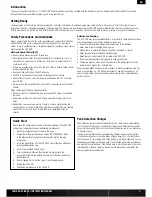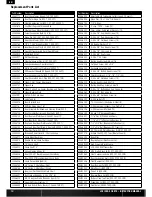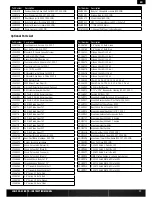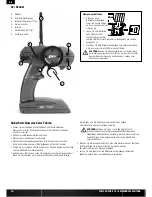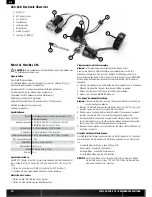
3
Losi XXX-sCB RTR • iNsTRuCTioN maNuaL
EN
Quick start
Please read the entire manual to gain a full understanding of the XXX-SCB
vehicle, fine-tuning the setup and performing maintenance..
1. Read the safety precautions found on this page.
2. Charge the battery pack you have chosen (NOT INCLUDED). Refer
to the Manufacturer’s Supplied instructions for battery charging
information.
3. Install the AA batteries into the LSR-3000 Transmitter. Use alkaline or
rechargeable batteries only.
4. Install a fully charged battery pack.
5. Turn on the transmitter and then the vehicle. Always turn the
transmitter on before the vehicle and turn it off after the vehicle has
been turned off.
6. Check steering. Verify that the servo is functioning properly.
7. Driving the XXX-SCB.
8. Performing maintenance of the XXX-SCB.
introduction
Thank you for purchasing the Losi
®
1/10 XXX-SCB. We are confident you will be satisfied with the performance of this durable and resilient vehicle. Please read
through the entire manual before setting up and using your vehicle.
Getting Ready
Thoroughly read all the enclosed material, precautions and follow instructions to avoid damaging your new RC vehicle. If you choose to not follow these steps or
instructions, it will be considered negligence. If after review of this manual and prior to running your XXX-SCB, you determine this RC vehicle is not what you want—
Do Not proceed and Do Not run the XXX-SCB. If the XXX-SCB has been run, your local hobby store will not be able to process a return or accept it for exchange.
safety Precautions and Guidelines
Always operate this RC model in a safe, reasonable and cautious fashion. When
driving the XXX-SCB avoid someone being hit by the vehicle. You may cause
serious injury to another person, or to personal property should you make contact
while running the XXX-SCB.
Electronic Speed Control (ESC)
• Read all safety precautions prior to each use.
• Never leave the vehicle/ESC unsupervised while it is switched on, in use or
connected to a power source. If there is a short-circuit or product defect, it
could result in fire.
• If there are exposed wires, do not use the ESC until you have installed shrink-
wrap or replaced the wire.
• Disconnect the battery from the ESC after use.
• The ESC is not waterproof and should not be exposed to moisture.
• Do not attempt to use 3-cell LiPo; doing so will damage the ESC and could
result in fire.
• Always turn on the transmitter first then the ESC to prevent an out-of-control
vehicle.
When setting your Electronic Speed Controller:
• Disconnect motor or remove the pinion gear during ESC setup or calibration
functions.
• Keep loose clothing, hair, gloves and fingers away from moving parts at all
times.
• Rubber tires can cause severe injury if there is a failure while running the
vehicle while on a stand or when being held. Ensure rubber tires are securely
mounted to the rims and if not, re-glue them and check them often for
security.
Batteries and Charging
The XXX-SCB uses rechargeable batteries such as NiMH. These batteries all have
special requirements to preserve performance and last.
• Read all instructions provided by the manufacturer of the batteries.
• Never allow minors to charge battery packs.
• Always check to ensure the polarity of battery connection is correct.
• Never leave batteries unattended while charging.
• Never charge a battery while it is installed in the XXX-SCB.
• Do not charge any battery that appears to have any damage.
• If there are exposed wires, do not charge or use the battery until you install
shrink-wrap or replace the complete wire.
When charging NiMH batteries, select a charger to meet your requirements. You
need a charger that is a 100-240V wall charger or one which requires a 12V
power supply. Follow the charger manufacturer’s instructions and precautions
during each use.
Peak Detection Charger
Peak detection chargers monitor the battery during charging and automatically
shut off upon full charge. You can either purchase a peak detection charger that
plugs into a household AC wall socket or one that requires you to also purchase a
12V power supply.
If using a charger other than a peak detection charger, make sure your battery
is fully discharged prior to charging. Many of these have a 15–20 minute timer
that allows you to set a charge time. If the battery is not fully discharged, you can
potentially over-charge your battery pack. Do not charge any battery unattended,
and monitor for heat build up. If the battery pack is more than warm to the touch,
immediately discontinue charging. Read all safety precautions supplied by the
charger and battery manufacturer.



